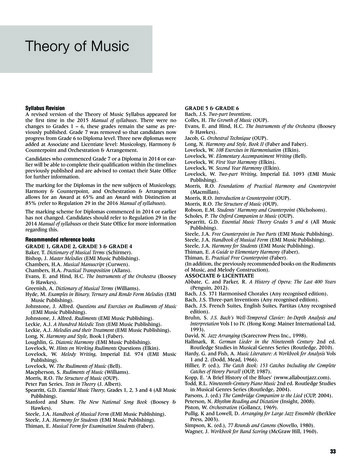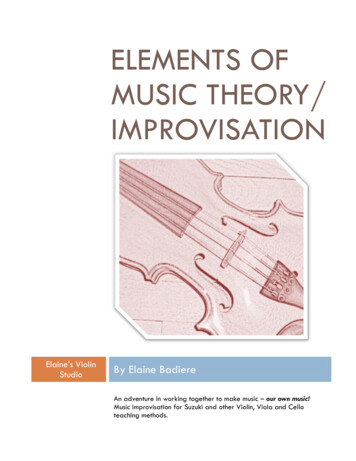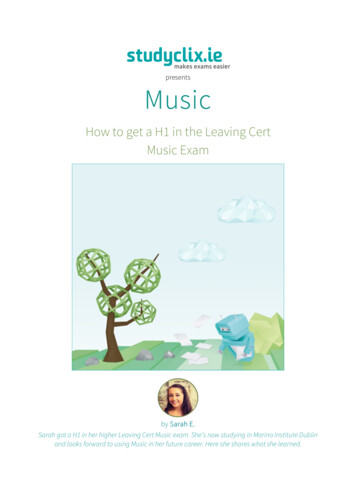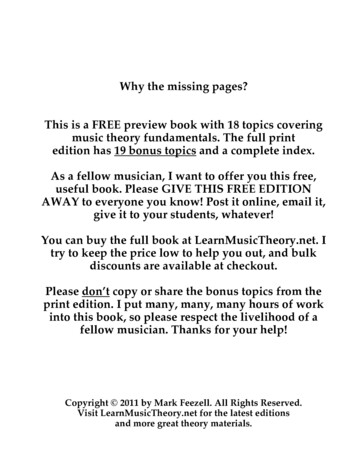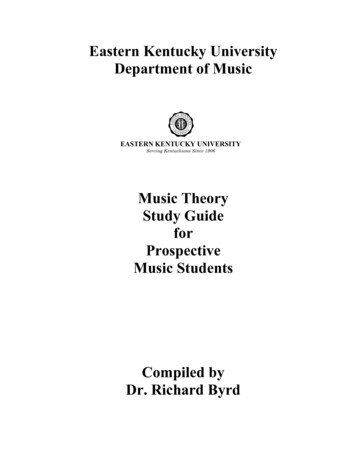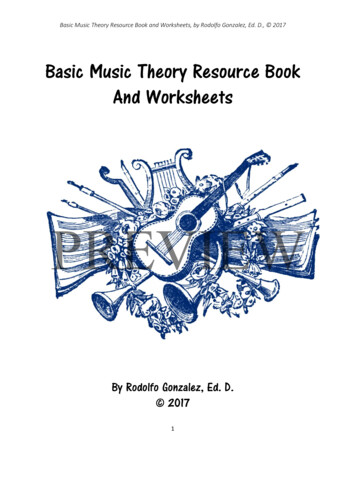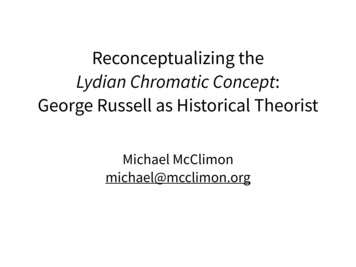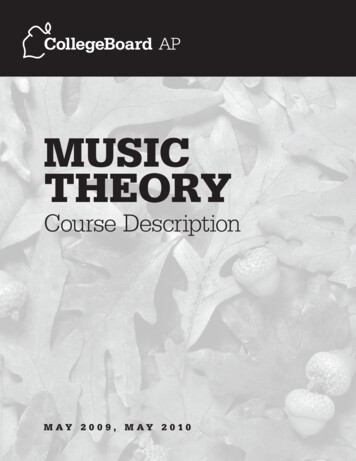
Transcription
The Framework of Music Theory asRepresented with GroupsAda ZhangJune 4, 2009Contents1 Introduction2 Basic Group Theory2.1 What is a group? . . . . . .2.2 Permutations . . . . . . . .2.3 Morphisms . . . . . . . . .2.3.1 Homomorphisms . .2.3.2 Isomorphisms . . . .2.3.3 Automorphisms . . .2.4 Products . . . . . . . . . . .2.4.1 Direct Products . . .2.4.2 Semidirect Products2.4.3 Wreath Products . .3.335667777883 Music Theory3.1 Basic concepts of atonal music theory . . . . . . . . . . . . . . .3.1.1 Tn , the Transpositions . . . . . . . . . . . . . . . . . . . .3.1.2 Tn I, the Inversions . . . . . . . . . . . . . . . . . . . . . .9910114 Group Theory as a Structure for AtonalMusic Theory115 A Flaw in Atonal Music Theory15.6 Uniform Triadic Transformations6.1 Introduction to Triadic Transformations6.2 V , the Uniform Triadic Transformations6.2.1 Multiplication on V . . . . . . .6.2.2 Inversion on V . . . . . . . . . .6.2.3 Isomorphism to Z12 o Z2 . . . . .6.2.4 Even and Odd UTTs . . . . . . .1.15161617182020
CONTENTS6.36.4R , the Riemannian UTTs . . . . . . . . . . . . . . . . . . . . . .K, the Subgroups of V . . . . . . . . . . . . . . . . . . . . . . . .21227 Musical Application228 Conclusion23Appendix24References262
2 Basic Group Theory1IntroductionIn 2002, a music theorist by the name of Julian Hook published a paper inthe Journal of Music Theory titled, “Uniform Triadic Transformations.” In thispaper, Hook generalized some existing music theoretical concepts and greatlyimproved their notation. Hook’s UTTs formed a group with interesting algebraicproperties.This paper will first give the reader a review of all necessary group theoryto understand the discussion of Hook’s UTTs. Then it will review music theory(atonal theory in particular) and its evolution to the UTTs. Finally, it willdiscuss the UTTs themselves and conclude with some musical applications.2Basic Group TheoryGroup theory is a branch of mathematics that studies groups. This algebraicstructure forms the basis for abstract algebra, which studies other structuressuch as rings, fields, modules, vector spaces and algebras. These can all beclassified as groups with addition operations and axioms.This section provides a quick and basic review of group theory, which willserve as the basis for discussions in the group theoretical structure as applied tomusic theory. Readers interested in a more thorough discussion to group theoryand abstract algebra may refer to [1] and [2].2.1What is a group?A group is a set such that any two elements x and y can be combined via“multiplication” to form a unique product xy that also lies in the set. Thismultiplication is defined for every group and does not necessarily refer to thetraditional meaning of “multiplication.” We now state the formal definition ofa group:Definition 2.1. A group is a set G together with a multiplication on G whichsatisfies three axioms:(a) The multiplication is associative, that is to say (xy)z x(yz) for anythree (not necessarily distinct) elements in G.(b) There is an element e G, called an identity element, such that xe x ex for every x G(c) Each element x G has an inverse x 1 which belongs to the set G andsatisfies x 1 x e xx 13
2 Basic Group TheoryTwo important properties follow easily from the definition of a group. Theproof of these properties is left to the reader.Theorem 2.2. Every group G satisfies the following properties:(a) The identity element e of G is unique(b) For all x G, the inverse x 1 is uniqueNote how commutivity of the multiplication is not required within a group.Therefore, we define an abelian group as follows:Definition 2.3. A group G is abelian if its multiplication is commutative.That is, xy yx for any two elements in G.To better illustrate the concept of a group, we now give some examples.Example 2.4. The reals excluding 0 R\{0} under multiplication: The group is closed under multiplication: for all x, y R, x · y R. The multiplication is associative: for all x, y, z R, (x · y) · z x · (y · z). The identity is 1: for all x R, 1 · x x x · 1. The inverse of x is1 1x: x· x 1 x · x1 .This group is abelian since x, y R, x · y y · x. Note how we must exclude 0for this to be a group since there exists no inverse for 0. That is, there does notexists some x R such that x · 0 1Example 2.5. The integers Z (mod 12), which we will denote as Z12 , underaddition (mod 12). (Note: in abstract algebra, Z (mod 12) is generally notatedas Z/(12) and Z12 refers to another algebraic structure. However, in musictheory, only Z (mod 12) is of significance and we will use this more concisenotation.) The group is closed under addition (mod 12): for all x, y Z12 ,x 12 y Z12 . Addition (mod 12) is associative. The identity is 0. The inverse of x is 12 x.This group is also abelian since for all x, y Z12 , x 12 y x 12 x.Example 2.6. The dihedral groups represent the symmetries of a regularpolygon that map it onto itself. Consider the regular hexagon. Let r denotethe rotation of through π/3 about the axis of symmetry perpendicular to thehexagon (rotating), let s denote the rotation through π about an axis of symmetry that lies in the plane of the plate (flipping), and let e denote the identity4
2 Basic Group Theory(leaving the hexagon unchanged). Then the dihedral group D6 consists of thefollowing 12 twelve elements, as shown in Figure 1.054321514035241302423120150453321054(a) e(b) r(c) r2(d) r3(e) r4(f) r5012152432035431405425105302143345012(g) s(h) rs(i) r2 s(j) r3 s(k) r4 s(l) r5 sFigure 1: Elements of D6It may seem that the group is not closed under multiplication since theelement sr is missing from the group. However, a rotation r takes the hexagonfrom Figure 1a to Figure 1b. A subsequent flip s takes the hexagon from Figure1b to Figure 1l. Thus, rs is equivalent to r5 s. The reader can check that thewhole group is indeed closed under multiplication. In general,srn r6 n s,for n Z6for the D6 dihedral group.Definition 2.7. The order of a group is the number of elements in the group.Definition 2.8. The order of some element x of a group G is the smallestpositive integer n such that xn eDefinition 2.9. A subgroup of a group G is a subset of G which itself formsa group under the multiplication of GDefinition 2.10. A group G is cyclic if there exists an x G such that for ally G, y xn for some n Z. We call x a generator of G.2.2PermutationsDefinition 2.11. A permutation of an arbitrary set X is a bijection from Xto itself.Permutations can be denoted in multiple ways. Consider r from the D6 dihedral group. We can represent it as a permutation of integers like so: (054321),where each integer is sent to the one following it, and the final one is sent tothe first. Likewise, we can write sr as (01)(25)(34).5
2 Basic Group TheoryDefinition 2.12. A permutation of the form (a1 a2 . . . ak ) is called a cyclicpermutation. A cyclic permutation of length k is called a k-cycle.Definition 2.13. A transposition is 2-cycle.Any k-cycle (a1 a2 . . . ak ) can be written as a product of transpositions:(a1 a2 . . . ak ) (a1 ak ) . . . (a1 a3 )(a1 a2 )Note that transpositions may be written as many different products. This product is not unique, but is meant to show the existence of a product consistingonly of transpositions.Definition 2.14. An even permutation is a permutation that can be writtenas an even number of transpositions. The others are called odd permutations.It may bother the reader that the a permutation in the form of a product oftranspositions is not unique. Perhaps a permutation could be written as bothan even number of transpositions and an odd number. However, the followingtheorem shows that the definition is well defined.Theorem 2.15. Although any permutation can be written as a product of transpositions in infinitely many different ways, the number of transpositions whichoccur is always even or always odd.Theorem 2.16. Consider the set X of n elements. The set of all permutationsof X forms a group Sn called the symmetric group of degree n. Multiplicationon this group is defined by composition of functions.2.32.3.1MorphismsHomomorphismsDefinition 2.17. Let G and G0 be groups. A homomorphism is a functionϕ : G G0 that preserves the multiplication of G. Therefore,for all x, y Gϕ(xy) ϕ(x)ϕ(y)Example 2.18. Let ϕ be a function from D12 to Z2 defined by ϕ(rn ) 0 andϕ(rn s) 1. Consider two elements x and y in D12 . We have four cases: x rm , y rn :ϕ(xy) ϕ(rm rn ) ϕ(rm n ) 0 0 0 ϕ(x)ϕ(y) x rm s, y rn :ϕ(xy) ϕ(rm srn ) ϕ(rm n s) 1 1 0 ϕ(x)ϕ(y) x rm , y rn s:ϕ(xy) ϕ(rm rn s) ϕ(rm n s) 1 0 1 ϕ(x)ϕ(y)6
2 Basic Group Theory x rm s, y rn s:ϕ(xy) ϕ(rm srn s) ϕ(rm n ss) ϕ(rm n ) 0 1 1 ϕ(x)ϕ(y)Hence, ϕ satisfies the properties of a homomorphism.2.3.2IsomorphismsDefinition 2.19. An isomorphism is a bijective homomorphism.Example 2.20. Z12 is isomorphic to Z3 Z4 . Consider the elements of Z3 Z4 )(1,3)(2,3)Send each element (x, y) to 4x y and you have Z122.3.3AutomorphismsDefinition 2.21. An automorphism of a group G is an isomorphism fromG to G. The set of all automorphisms forms a group under composition offunctions, which is called the automorphism group of G and written Aut(G).Automorphisms fix the identity and send generators to generators.Example 2.22. Consider the automorphisms of Z4 . There are only two generators in this group: 1 and 3. Therefore, there are only two elements in Aut(Z4 ):the trivial one, and the one that flips 1 and 3.2.42.4.1ProductsDirect ProductsTheorem 2.23. The set G H of two groups G and H is a group that consistsof the elements (g, h) where g G and h H. Given two elements (g, h) and(g 0 , h0 ) of G H, multiplication on this group is defined by(g, h)(g 0 , h0 ) (gg 0 , hh0 )where the first term, gg 0 , inherits the multiplication of G, and the second, hh0 ,inherits the multiplication of H. We call this group the direct product G Hof G and H.Proof. Associativity follows from the associativity in both G and H. The identity is (e, e) and the (g 1 , h 1 ) is the inverse of (g, h).Example 2.24. Consider Z4 Z2 . This group has 8 ,(3,1).Multiplication is defined by(x, y) (x0 , y 0 ) (x 4 x0 , y 2 y 0 )7
2 Basic Group Theory2.4.2Semidirect ProductsTheorem 2.25. Suppose we have the groups G, H and the homomorphismϕ : G Aut(H). Then the “twisted” direct product G o H forms a new group.Its elements are of the form (g, h) with g G and h H and multiplication isdefined by(g, h)(g 0 , h0 ) (g · ϕ(h)(g 0 ), h · h0 ).We call this group the semidirect product of G and H.Example 2.26. Consider the semidirect product Z4 o Z2 . The elements in thisgroup are the same as those in Z4 Z2 as listed in Example 2.24.We need to define ϕ. There are only two automorphisms of Z4 as shown inExample 2.22. Let the trivial automorphism be denoted with e and the otherwith σ. Then, since ϕ : Z2 Aut(H), we have ϕ(0) e and ϕ(1) σ.Now we can perform multiplication on the group. Consider multiplying theelements (0, 0) and (1, 0). Since ϕ(0) e this multiplication is just like that ofthe direct product:(0, 0)(1, 0) (0 ϕ(0)1, 0 0) (0 e(1), 0 0)(1, 0)Now consider the elements (1, 0) and (0, 1).(0, 1)(1, 0) (0 ϕ(1)(1), 1 0) (0 σ(1), 1 0) (3, 1)Example 2.27. We can rewrite the elements of Z4 as e, r, r2 and r3 and theelements of Z2 as e and s. Converting the elements we used in the aboveexample, we have (0, 0) e, (1, 0) r and (0, 1) s. Then,(0, 0)(1, 0) er rand(0, 1)(1, 0) sr σ(s)(r)s r3 sNote how the multiplication is “twisted”. That is, to “pull” the r past the s,we have to twist and change it a little bit. We can clearly see that Z4 Z2 isisomorphic to the dihedral group D4 .2.4.3Wreath ProductsThe generalized form of a wreath product G o H is too complicated for the scopeof this paper. Therefore, we will only consider the special case taking a wreathproduct with Z2 .Consider the group G. Then G o Z2 is isomorphic to (G G) o Z2 . Wewill discuss this semidirect product in the dihedral notation as in Example 2.27.Thus, let the elements of G G be denoted by r1m r2n .The automorphism for a wreath product must permute the parts of an element in G G. Since we only have two elements, r1m and r2n , the only non-trivialautomorphism is to switch them. That is σ(r1m r2n ) r2n r1m . Thus,r1m r2n s sσ(r1m r2n ) sr2n r1m .8
3 Music Theory3Music TheoryMusic theory is a tool and framework with which we explain our listening experience. However, both the tool and the term “listening experience” are looselydefined. They are dependent on the music.During the mid-15th century, composers began constructing their piecesaround a particular pitch, called the tonic. This pitch was quickly establishedat the start of the piece and all other pitches were heard relative to it. Intervalsand chords were labeled as consonant or dissonant. A feeling of tension occurredin various ways, such as when resolution was delayed, or when the music leaptto distant keys (more than two accidentals removed from the tonic). Resolutionto the tonic was crucial to ending the piece. After over two centuries of tonalmusic, listeners have begun to expect music to resolve in particular ways.Along with the development of tonal music was the development of tonaltheory. Its structure and notation allowed theorists to describe the listener’sexpectation. Thus, it provided an explanation for our reaction to particularharmonies. It explained our feeling of surprise at a particular chord and ourfeeling of finality at the end of a piece.Around the turn of the 19th century, composers pushed the boundaries oftonal music. They began using dissonant chords with unprecedented freedomand resolved them in new ways. Eventually, their pieces no longer fit the framework of tonal music. Tonal theory no longer provided an adequate explanationfor our listening experience. Thus, a new framework was constructed calledatonal music theory.Discussions in music require a certain vocabulary. The following terms aredefined in the appendix: interval half step (semitone) & whole step (whole tone) flat, sharp, natural & accidental enharmonic equivalence major, minor, mode parallel & relative scale degree triad3.1Basic concepts of atonal music theoryAtonal music is based on sequences of pitches and intervals. No particular pitchis considered more important than the others and resolution of dissonance isunimportant. It assumes octave and enharmonic equivalence.9
3 Music TheoryDefinition 3.1. Pitches that are separated by an integer multiple of an octave,or are enharmonically equivalent belong to the same pitch class.Each pitch class is assigned an integer as shown in Table 1.Table 1: Pitch-Class IntegersInteger01234567891011Possible NotationB], C, D[[C], D[C , D, E[[D], E[D , E, F[E], F, G[[F], G[F , G, A[[G], A[G , A, B[[A], B[A , B, C[Pitch-classes are separated by intervals. In atonal music theory, they consider four different definitions of “interval” to aid analysis. However, we willgive only one:Definition 3.2. Consider the pitches a and b. The ordered pitch-class interval from a to b is a b (mod 12).Definition 3.3. A pitch-class set is an unordered set of pitch-classes, denotedas a string of integers enclosed in brackets. Within a pitch-class set, we do nothave information about the register, rhythm or order of the pitches.Example 3.4. The C major triad consists of the notes C, E and G. This canbe represented as the pitch-class set [047], since C 0, E 4 and G 7 asshown in Table 1.In atonal music, operations are performed on pitch-class sets, creating newpitch-class sets that are spread throughout the music. Thus, the music soundsrandom and yet structured at the same time. We will discuss two types ofoperations in this paper: the transpositions and the inversions.3.1.1Tn , the TranspositionsDefinition 3.5. The transposition Tn moves a pitch-class or pitch-class set upby n (mod 12). (Note: moving down by n is equivalent to moving up by 12 n.)Figure 2 from page 34 of [4] shows two lines from Schoenberg’s String QuartetNo. 4, which are related by T6 . Note how the pitch-class intervals between notes10
4 Group Theory as a Structure for AtonalMusic Theoryremains do not change. Figure 3 from page 35 of [4] shows a more complicatedanalysis of Webern’s Concerto for Nine Instruments, Op. 24, second movement,which depicts four different pitch-class sets related by different transpositions.Figure 2: Two lines of pitch classes related by T6 (Schoenberg, String QuartetNo. 4).3.1.2Tn I, the InversionsDefinition 3.6. Consider the pitch a. Inversion Tn I inverts the pitch about C(0) and then transposes it by n. That is, Tn I(a) a n (mod 12).Figure 4 from page 40 of [4] shows two lines from Schoenberg’s String QuartetNo. 4, which are related by T9 I. Note how the pitch-class intervals of size nhave all been inverted to 12 n. Figure 5 from page 41 of [4] shows an analysisof the Schoenberg, Piano Piece, Op. 11, No. 1, which depicts three differentpitch-class sets related by different inversions.4Group Theory as a Structure for AtonalMusic TheoryThe numbering of the pitch classes reveals their isomorphism to Z12 . Moreinterestingly, the group of transpositions and inversions, denoted Tn /Tn I isisomorphic to the dihedral group D12 .11
4 Group Theory as a Structure for AtonalMusic TheoryFigure 3: Transpositionally equivalent pitch-class sets (Webern, Concerto forNine Instruments, Op. 24).12
4 Group Theory as a Structure for AtonalMusic TheoryFigure 4: Two lines of pitch classes related by T9 I (Schoenberg, String QuartetNo. 4)Figure 5: Inversionally equivalent pitch-class sets (Schoenberg, Piano Piece, Op.11, No. 1)13
4 Group Theory as a Structure for AtonalMusic TheoryImagine laying out all the pitches in a circular pattern on a 12-sided polygon.Then we have:11 (B)0 (C)10 (A])1 (C])2 (D)9 (A)3 (D])8 (G])7 (G)4 (E)6 (F])5 (F)Consider the transposition T11 . It sends C to B, C]to C, etc. That is,11 (B)0 (C)10 (A])1 (C])2 (D)9 (A)5 (F)1 (C)2 (C])9 (G])4 (E)6 (F])0 (B)10 (A)3 (D])8 (G])7 (G)11 (A])3 (D)8 (G)T117 (F])4 (D])6 (F)5 (E)Now consider the inversion T1 I. It sends C to D], D]to C, D to B, etc. Thisgives:11 (B)0 (C)10 (A])1 (C])2 (D)9 (A)5 (F)3 (A])8 (F)T1 I7 (F])1 (C)2 (B)9 (E)4 (E)6 (F])0 (C])10 (D])3 (D])8 (G])7 (G)11 (D)4 (A)6 (G)5 (G])Note the striking similarity of T11 and T1 I to r and sr of D12 . We can clearlysee that the Tn /Tn I group is isomorphic to D12 by Tn r12 n and Tn I rn s.14
6 Uniform Triadic Transformations5A Flaw in Atonal Music TheoryConsider the operation that changes a major triad to a minor triad. To ourears, this is the same operation regardless of whether we start with a CM triador a DM triad. However, consider the CM triad as the pitch class [047], cm as[037], DM as [269] and dm as [259]. Then, we haveCM cm [047] [037] T7 IDM dm [269] [259] T11 IThis is a misleading representation of the music, because our ears do not heartwo different actions. Therefore, the structure of atonal music theory has aninherent flaw. It cannot support these simple transformations.A music theorist named Hugo Riemann recognized this problem. He inventedthe idea of a “triadic transformation.” Later music theorists devised three operations, called Neo-Riemannian operations, that functioned specifically on triads: The Parallel operation (P) moves the middle note of a triad up or downa semitone such that a major triad becomes minor and a minor triadbecomes major. For example, it would move the E in a CM to an E[ andthe E[ in a cm triad to an E\. The Leading-tone exchange (L) moves the bottom note of a major triaddown a semitone and the top note of a minor triad up a semitone. Thus,a CM triad would turn into an em triad, and a cm triad would turn intoan A[M triad. The Relative operation (R) sends a chord to its relative counterpart bymoving the top note of a major triad up by a whole tone, and moving thebottom note of a minor triad down by a whole tone. Thus, a CM triadwould turn into an am triad, and a cm triad would turn into an E[M triad.These three were particularly interesting because they allowed for parsimoniousvoice-leading. That is, in moving from one triad to another, only one voice (top,middle or bottom) moved, and it moved by nothing more than a whole step.In addition, they allowed a transformation from any one chord to another bycomposition of these operations.6Uniform Triadic TransformationsThis P , L and R notation, while a definite imporvement, could still be unclear,unwieldy and limited in its usefulness. For example, a move from a CM triad to ab[m triad requires a minimum of six Neo-Rimannian operations. Furthermore,there are nine different ways to write it in six operations: LPRPR, LRPRP,PLRLR, PRLRP, PRPRL, RLPLR, RLRLP, RPLPR, RPRPL. Of course, thereare even more ways to write it in more than six operations. Not only has thisnotation become pedantic, it also fails to reflect the music: who would hear sixoperations in a simple move from CM to b[m?15
6 Uniform Triadic TransformationsTo resolve this problem, another music theorist named Julian Hook deviseda new notation for transformations on triads, which he called uniform triadictransformations (UTTs). This notation, in fact, was a group structure withintriguing algebraic properties. Before we jump into a discussion on Hook’sUTTs, let us first provide some definitions.Definition 6.1. A triad is an ordered pair (r, σ) where r is the root ofthe triad expressed as an integer (mod 12), and σ is a sign representing its mode( for major, for minor).Example 6.2. (0, ) represents a C major triad and (6, ) representsan f] minor triad.Theorem 6.3. The set of all 24 major and minor triads, forms a abelian groupwith multiplication defined by(t1 , σ1 )(t2 , σ2 ) (t1 t2 , σ1 σ2 )We call this set Γ.Proof. This group is clearly isomorphic to Z12 Z2 , which by Theorem 2.23 isa group.Definition 6.4. Given 1 (r1 , σ1 ) and 2 (r2 , σ2 ), the transpositionlevel t r2 r1 is the interval between the roots and the sign factor σ σ1 σ2 isthe change in sign. (σ is multiplied as expected with , , and .) The Γ-interval int( 1 , 2 ) is the ordered pair (t, σ) where tand σ are the transposition level and sign factor as defined above.Example 6.5. The Γ-interval from (0, ) (C major) to (6, ) (f] minor) is(6, ).6.1Introduction to Triadic TransformationsDefinition 6.6. A triadic transformation is a bijective mapping from Γ toitself. In other words, it is a permutation of Γ.Theorem 6.7. The set of all triadic transformations forms a group G .Proof. After numbering the triads, this group is clearly isomorphic to S24 .The order of G is huge: 24 factorial. However, most of these transformationshave little musical meaning since the action of a transformation on one triadmay not resemble its action on another triad.6.2V , the Uniform Triadic TransformationsOf particular musical interest are the UTTs because they operate on all majortriads in the same manner. Similarly, the UTTs have one action for all minortriads.16
6 Uniform Triadic TransformationsDefinition 6.8. Consider the triadic transformation that transforms (r, σ) to(r0 , σ 0 ). It is a uniform triadic transformation (UTT) if it transforms(r t, σ) to (r0 t, σ 0 ) for all t Z12 .It is important to note that not all musically interesting transformations areUTTs. The inversions Tn I, for example, are not part of the UTTs.Any UTT is completly determined by three parameters: t , its transposition level for a major triad t , its transposition level for a minor triad σ, its sign. (Note: it may seem that σ could be different for major andminor triads. However, in order to be a transformation, a UTT must mapΓ to itself. Thus, if it switches major triads to minor, it must switch minortriads to major. That is σ σ . Positive σ implies no change in mode(it is mode-preserving), negative σ implies switching to the oppositemode (it is mode-reversing).)We can thus denote any UTT U by the ordered triple U σ, t , t .Example 6.9. We will convert Riemann’s P , L and R in UTT notation:P , 0, 0 L , 4, 8 R , 9, 3 Note, Hook uses left-to-right orthography. Thus, U 1U 2 implies “first U 1then U 2.” As usual, U 2 U U , etc. Although it is less intuitive for mathematicians, we will adhere to his notation.6.2.1Multiplication on VMultiplication on V should clearly be composition. Before we derive a general formula for the composition of two UTTs, let us consider some concreteexamples.Example 6.10. Consider the UTTs U , 4, 7 and V , 5, 10 . Let us calculate the product U V σU V , t U V , tU V . When U V acts on a CMtriad ( (0, )) we have:UV(0, ) (4, ) (9, ).Thus, U V transforms the major triads through the Γ-interval (9, ). We candeduce that σU V and t U V 9.When U V acts on a cm triad ( (0, )) we have:UV(0, ) (7, ) (5, ).17
6 Uniform Triadic TransformationsThus, U V transforms the minor triads through the Γ-interval (5, ) and t UV 5. Hence, U V , 9, 5 This product may be calculated by multiplying the signs (σU V σU σV ) and adding the corresponding transposition levels (t U V tU tV and tU V tU tV ).Figure 6 from page 72 of [3] depicts a visual representation of U V .Example 6.11. Now consider the product V U . In this case we haveVU(0, ) (5, ) (0, ),andVU(0, ) (10, ) (2, ).Therefore, V U , 0, 2 . In this case, the signs were multiplied as before, the transposition levels were “cross-added.” That is, t U V tV tU and tU V tV tU .We can see that in the above example, the “cross-adding” was due to thesign of the first transformation. In the first case, the first UTT (U ) was modepreserving, so the second UTT (V ) acted on the same mode as U . Thus, thecorresponding transposition levels were applied in succession. In the secondcase, the first UTT (V ) was mode-reversing, so the second UTT (U ) acted onthe opposite mode as V and opposite transposition levels were combined. Thisleads us to the general form of UTT multiplication: Theorem 6.12. Consider two UTTs U σU , t U , tU and V σV , tV , tV . Multiplication on V is given by(σU )U V σU σV , t U tV( σU ), t U tV The reader can verify that following the process above using two arbitraryelements in V will give the desired result.6.2.2Inversion on VAgain, before we derive a general formula for the inverse of a UTT, let usconsider some concrete examples.UExample 6.13. Consider the UTT U , 4, 7 . Because (0, ) (4, )U 1UU 1and (0, ) (7, ), we need (4, ) (0, ) and (7, ) (0, ). Thus,U 1 , 8, 5 . Note how this is simply the inversion of the transpositionlevels: , 4 (mod 12), 7 (mod 12) .VExample 6.14. Now consider the UTT V , 5, 10 . (0, ) (5, ) andVV 1V 1(0, ) (10, ). Thus, (5, ) (0, ) and (10, ) (0, ). Therefore,V 1 2, 7 or , 10 (mod 12), 5 (mod 12) . In this case, thetransposition levels are not only inverted, but interchanged. Once again, this isdue to the sign of V .18
Figure 6: Visual representation of the UTT equation , 4, 7 , 5, 10 , 9, 5 6 Uniform Triadic Transformations19
6 Uniform Triadic TransformationsSimilarly to multiplication, the inverse of a UTT can be derived to be asfollows:Theorem 6.15. Consider the UTT U σ, t , t . Its inverse is given byU 1 σ, tσ , t( σ) 6.2.3Isomorphism to Z12 o Z2With some analysis, we come upon the highly interesting and significant resultthat V is isomorphic to Z12 o Z2 . This isomorphism gives V any and all resultsalready proven about Z12 o Z2 .Theorem 6.16. The set V of UTTs is a group that is isomorphic to Z12 o Z2 .Proof. Remember from Section 2.4.3 how we represented G G in the formr1m r2n . Let G be Z12 and let us switch the 1 and 2 to and -. Then them nelements of Z12 o Z2 are sr r where m, n Z12 .Also note that the transpositions, which are equivalent to the transpositionlevels of a UTT, are isomorphic to the rotations of the D12 by Tn rn . (Note:we initially wrote in Section 4 that the Tn /Tn I group was isomorphic byTn r12 n . This reflected our visual representation of the two groups. However, the groups are still isomorphic if we choose Tn rn , which makes thefollowing argument clearer.)It seems likely that the UTTs are isomorphic to Z12 o Z2 bym nr . We have already shown that the UTTs have multipli σ, t , t sr cation and inverses. We only need to show that it follows the multiplication ofn mm nr ).r )s s(r Z12 o Z2 . That is, (r m nm n(r r )s (er r )(see) , 0, 0 , t m , tn ,this is a little backwards because , 0 t n,0 , tn , tm n m s(r r )mathematicians use right-to-left t m orthography and Hook uses left-toright orthographyThus, multiplication is preserved and the isomorphism holds.6.2.4Even and Odd UTTsUTTs can be classified as “even” or “odd” in multiple ways. Let us begin with“even/odd in the sense of total transposition.”Definition 6.17. We say that a UTT U σ, t , t is even (or, more fully,even in the sense of total transposition) if its total transposition τ (U ) t t is an even number. U is odd (in the sense of total transposition)if τ (U ) is an odd number.20
6 Uniform Triadic TransformationsExample 6.18. The UTTs P , 0,
This paper will rst give the reader a review of all necessary group theory to understand the discussion of Hook's UTTs. Then it will review music theory (atonal theory in particular) and its evolution to the UTTs. Finally, it will discuss the UTTs themselves and conclude with some musical applications. 2 Basic Group Theory



